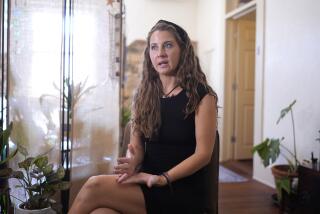Texas hospital defends actions; governor may declare emergency
The Texas hospital where two nurses were infected with the Ebola virus said Thursday that it followed federal guidelines to protect against the spread of the deadly pathogen, as Dallas County officials called an emergency meeting to consider asking Gov. Rick Perry to declare a local emergency.
The move comes after two registered nurses, Nina Pham and Amber Vinson, were diagnosed with Ebola infections after treating Liberian Thomas Eric Duncan, who died Oct. 8 at Texas Health Presbyterian Hospital.
Controversy continued to swirl over why Vinson flew on commercial flights to Cleveland and back to Dallas while she was among dozens of healthcare workers who had been asked to monitor and report potential Ebola infection signs and symptoms.
Vinson contacted the agency Monday, before her return flight on Frontier Airlines, reporting she had a low-grade fever of about 99.5, two degrees below what then was the agency’s threshold, 101.5, according to the agency. That mark was lowered by the agency Wednesday, to 100.4, still above Vinson’s reported fever level.
A member of a team of CDC officials consulted the agency’s guidelines and cleared her to fly home, according to a federal official, speaking on condition of anonymity because the Ebola outbreak in Dallas continues to be investigated.
“Since they were wearing protective equipment, they were in a category of unknown risk,” the federal official said.
There was no record of whether Vinson had informed the CDC that she was traveling to Ohio on Oct. 10, the official added.
Texas Health Services, which operates the hospital where Vinson and Pham were infected, issued a statement Thursday clarifying its handling of Duncan, who was sent home from the emergency room Sept. 25, only to return three days later with a fever, vomiting and diarrhea.
Nurses have complained that Duncan was not isolated properly during that first visit, and that his laboratory samples were sent for analysis using the hospital’s pneumatic tube delivery system.
Those samples were first sealed in a plastic bag, according to the hospital. “At no time did Mr. Duncan’s specimens leak or spill – either from their bag or their carrier – into the tube system,” the statement said.
Upon his return to the hospital via ambulance, Duncan was “moved directly to a private room and placed in isolation,” according to the hospital.
On that second visit, the hospital said, “the tube system was not used at all. His specimens were triple-bagged, placed in a container, and placed into a closed transport container and hand-carried to the lab utilizing the buddy system.”
“Additionally, while Mr. Duncan was in the [intensive care unit], all lab specimens were hand-carried and sealed per protocol. Routine labs were done in his room via wireless equipment,” the statement said.
Staff was provided with protective garb “consistent with CDC guidelines at the time,” the hospital added.
“Staff had shoe covers, face shields were required, and an N-95 mask was optional, again, consistent with the CDC guidelines at the time,” the hospital said. The statement did not elaborate on whether face shields or masks were worn.
Nurses have said there was debate about whether the facial protection was necessary. Speaking anonymously through the National Nurses United union in Oakland on Tuesday, several nurses with knowledge of Duncan’s treatment also said that protective gear left their skin exposed, requiring them to use several layers of medical tape to seal off those areas.
“When the CDC issued updates, as they did with leg covers, we followed their guidelines,” the hospital said. “When the CDC recommended that nurses wear isolation suits, the nurses raised questions and concerns about the fact that the skin on their neck was exposed. The CDC recommended that they pinch and tape the necks of the gown. Because our nurses continued to be concerned, particularly about removing the tape, we ordered hoods.”
It was unclear from the statement when the hospital switched from gowns to more robust isolation suits.
“Admittedly, when we received Tyvek suits, some were too large,” the statement said. “We have since received smaller sizes, but it is possible that nurses used tape to cinch the suits for a better fit.
The hospital added additional points intended to rebut allegations made by nurses on Tuesday:
“The CDC classified risk/exposure levels. Nurses who were classified as “no known exposure” or “no risk” were allowed to treat other patients per the CDC guidance.
“Per the CDC guidelines, patients who may have been exposed were always housed or isolated per the CDC guidance.
“Regarding hazardous waste, the hospital went above and beyond the CDC recommendations. Waste was well-contained in accordance with standards, and it was located in safe and containable locations.”
The hospital announced Wednesday that it has offered rooms to any of its workers who are anxious about potentially spreading infection to people at home.
Dallas County officials were meeting with Gov. Perry and his staff Thursday morning, Dallas County Judge Clay Jenkins said during an appearance on the “Fox & Friends” morning talk show.
Jenkins added that healthcare workers who came in contact with Duncan “did not have clear instructions” from the CDC.
“We placed orders on the 75 individuals, who are healthcare workers, restricting them from flights, “ said Jenkins, who presides over a five-member Commissioners Court that has administrative and budget authority for county government.
“These are legally binding documents that we put on them, but these are good people,” Jenkins said. Vinson, he added, “would not have gotten on that flight if she had not been told to do so.”
More to Read
Sign up for Essential California
The most important California stories and recommendations in your inbox every morning.
You may occasionally receive promotional content from the Los Angeles Times.











